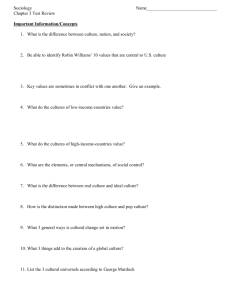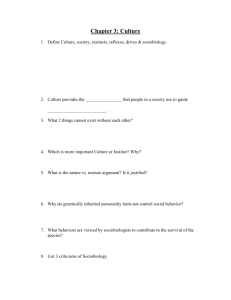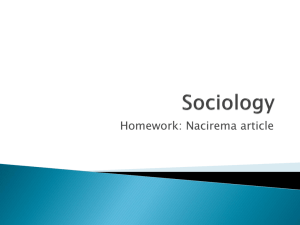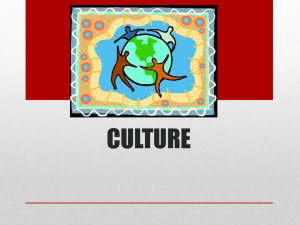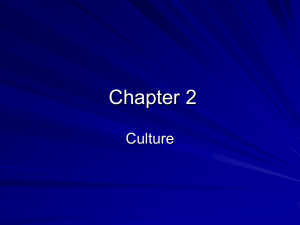Chptr03 & Chatr04
advertisement
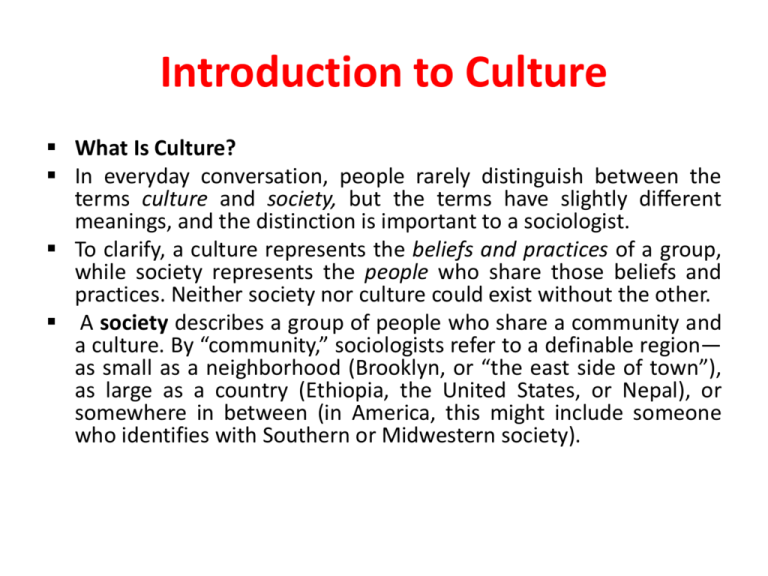
Introduction to Culture What Is Culture? In everyday conversation, people rarely distinguish between the terms culture and society, but the terms have slightly different meanings, and the distinction is important to a sociologist. To clarify, a culture represents the beliefs and practices of a group, while society represents the people who share those beliefs and practices. Neither society nor culture could exist without the other. A society describes a group of people who share a community and a culture. By “community,” sociologists refer to a definable region— as small as a neighborhood (Brooklyn, or “the east side of town”), as large as a country (Ethiopia, the United States, or Nepal), or somewhere in between (in America, this might include someone who identifies with Southern or Midwestern society). Types of Culture Material culture refers to the objects or belongings of a group of people. Metro passes and bus tokens are part of material culture, as are automobiles, stores, and the physical structures where people worship. Nonmaterial culture, in contrast, consists of the ideas, attitudes, and beliefs of a society. Material and nonmaterial aspects of culture are linked, and physical objects often symbolize cultural ideas. A metro pass is a material object, but it represents a form of nonmaterial culture, namely, capitalism, and the acceptance of paying for transportation. Clothing, hairstyles, and jewellery are part of material culture, but the appropriateness of wearing certain clothing for specific events reflects nonmaterial culture. A school building belongs to material culture, but the teaching methods and educational standards are part of education’s nonmaterial culture. Types of Culture ideal culture, the standards society would like to embrace and live up to. But ideal culture differs from real culture, the way society actually is, based on what occurs and exists. In an ideal culture, there would be no traffic accidents, murders, poverty, or racial tension. But in real culture, police officers, lawmakers, educators, and social workers constantly strive to prevent or repair those accidents, crimes, and injustices. American teenagers are encouraged to value celibacy. However, the number of unplanned pregnancies among teens reveals that not only is the ideal hard to live up to, but that the value alone is not enough to spare teenagers from the potential consequences of having sex. Types of Culture Sociologists use the term high culture to describe the pattern of cultural experiences and attitudes that exist in the highest class segments of a society. People often associate high culture with intellectualism, political power, and prestige. In America, high culture also tends to be associated with wealth. Events considered high culture can be expensive and formal—attending a ballet, seeing a play, or listening to a live symphony performance. Types of Culture The term popular culture refers to the pattern of cultural experiences and attitudes that exist in mainstream society. Popular culture events might include a parade, a baseball game, or the season finale of a TV show. Rock and pop music—“pop” short for “popular”—are part of popular culture. In modern times, popular culture is often expressed and spread via commercial media such as radio, television, movies, the music industry, publishers, and corporate-run websites. Unlike high culture, popular culture is known and accessible to most people. Cultural Universals Cultural universals are patterns or traits that are globally common to all societies. One example of a cultural universal is the family unit: every human society recognizes a family structure that regulates sexual reproduction and the care of children. Even so, how that family unit is defined and how it functions vary. In many Asian cultures, for example, family members from all generations commonly live together in one household. In these cultures, young adults will continue to live in the extended household family structure until they marry and join their spouse’s household, or they may remain and raise their nuclear family within the extended family’s homestead. In the United States, by contrast, individuals are expected to leave home and live independently for a period before forming a family unit consisting of parents and their offspring. Cultural Universals Anthropologist George Murdock first recognized the existence of cultural universals while studying systems of kinship around the world. Murdock found that cultural universals often revolve around basic human survival, such as finding food, clothing, and shelter, or around shared human experiences, such as birth and death, or illness and healing. Ethnocentrism Ethnocentrism, involves evaluating and judging another culture based on how it compares to one’s own cultural norms. Ethnocentrism, as sociologist William Graham Sumner (1906) described the term, involves a belief or attitude that one’s own culture is better than all others. Almost everyone is a little bit ethnocentric. For example, Americans tend to say that people from England drive on the “wrong” side of the road, rather than the “other” side. Someone from a country where dog meat is standard fare might find it off-putting to see a dog in a French restaurant—not on the menu, but as a pet and patron’s companion. Cultural imperialism Cultural imperialism, involves the deliberate imposition of one’s own cultural values on another culture. Europe’s colonial expansion, begun in the 16th century, was often accompanied by a severe cultural imperialism. European colonizers often viewed the people in the lands they colonized as uncultured savages who were in need of European governance, dress, religion, and other cultural practices. A more modern example of cultural imperialism may include the work of international aid agencies who introduce agricultural methods and plant species from developed countries while overlooking indigenous varieties and agricultural approaches that are better suited to the particular region. Cultural relativism Cultural relativism is the practice of assessing a culture by its own standards rather than viewing it through the lens of one’s own culture. Practicing cultural relativism requires an open mind and a willingness to consider, and even adapt to, new values and norms. However, indiscriminately embracing everything about a new culture is not always possible. Even the most culturally relativist people from egalitarian societies—ones in which women have political rights and control over their own bodies—would question whether the widespread practice of female genital mutilation in countries such as Ethiopia and Sudan should be accepted as a part of cultural tradition. Sociologists attempting to engage in cultural relativism, then, may struggle to reconcile aspects of their own culture with aspects of a culture they are studying. Xenocentrism Sometimes when people attempt to rectify feelings of ethnocentrism and develop cultural relativism, they swing too far to the other end of the spectrum. Xenocentrism is the opposite of ethnocentrism, and refers to the belief that another culture is superior to one’s own. (The Greek root word xeno, pronounced “ZEE-no,” means “stranger” or “foreign guest.”) An exchange student who goes home after a semester abroad or a sociologist who returns from the field may find it difficult to associate with the values of their own culture after having experienced what they deem a more upright or nobler way of living. Elements of Culture Values and Beliefs Values are a culture’s standard for discerning what is good and just in society. Values are deeply embedded and critical for transmitting and teaching a culture’s beliefs. Beliefs are the tenets or convictions that people hold to be true. Individuals in a society have specific beliefs, but they also share collective values. To illustrate the difference, Americans commonly believe in the American Dream—that anyone who works hard enough will be successful and wealthy. Underlying this belief is the American value that wealth is good and important. sanction People sanction certain behaviors by giving their support, approval, or permission, or by instilling formal actions of disapproval and non-support. Sanctions are a form of social control, a way to encourage conformity to cultural norms. Sometimes people conform to norms in anticipation or expectation of positive sanctions: good grades, for instance, may mean praise from parents and teachers. Norms Norms define how to behave in accordance with what a society has defined as good, right, and important, and most members of the society adhere to them. Formal norms are established, written rules. They are behaviours worked out and agreed upon in order to suit and serve the most people. Laws are formal norms, but so are employee manuals, college entrance exam requirements, and “no running” signs at swimming pools. Formal norms are the most specific and clearly stated of the various types of norms, and the most strictly enforced. But even formal norms are enforced to varying degrees, reflected in cultural values. Norms There are plenty of formal norms, but the list of informal norms—casual behaviours that are generally and widely conformed to—is longer. People learn informal norms by observation, imitation, and general socialization. Some informal norms are taught directly—“Kiss your Aunt Edna” or “Use your napkin”—while others are learned by observation, including observations of the consequences when someone else violates a norm. But although informal norms define personal interactions, they extend into other systems as well. Think back to the discussion of fast food restaurants at the beginning of this chapter. In the United States, there are informal norms regarding behaviour at these restaurants. Customers line up to order their food, and leave when they are done. They don’t sit down at a table with strangers, sing loudly as they prepare their condiments, or nap in a booth. Norms Norms may be further classified as either mores or folkways. Mores (mor-ays) are norms that embody the moral views and principles of a group. Violating them can have serious consequences. The strongest mores are legally protected with laws or other formal norms. In the United States, for instance, murder is considered immoral, and it’s punishable by law (a formal norm). But more often, mores are judged and guarded by public sentiment (an informal norm). People who violate mores are seen as shameful. They can even be shunned or banned from some groups. The mores of the U.S. school system require that a student’s writing be in the student’s own words or use special forms (such as quotation marks and a whole system of citation) for crediting other writers. Writing another person’s words as if they are one’s own has a name—plagiarism. The consequences for violating this norm are severe, and can usually result in expulsion. Norms Unlike mores, folkways are norms without any moral underpinnings. Rather, folkways direct appropriate behaviour in the day-to-day practices and expressions of a culture. Folkways indicate whether to shake hands or kiss on the cheek when greeting another person. They specify whether to wear a tie and blazer or a T-shirt and sandals to an event. In Canada, women can smile and say hello to men on the street. In Egypt, it’s not acceptable. In regions in the southern United States, bumping into an acquaintance means stopping to chat. It’s considered rude not to, no matter how busy one is. In other regions, people guard their privacy and value time efficiency. A simple nod of the head is enough. Symbols Symbols—such as gestures, signs, objects, signals, and words—help people understand the world. Symbols provide clues to understanding experiences. They convey recognizable meanings that are shared by societies. The world is filled with symbols. Sports uniforms, company logos, and traffic signs are symbols. In some cultures, a gold ring is a symbol of marriage. Some symbols are highly functional; stop signs, for instance, provide useful instruction. As physical objects, they belong to material culture, but because they function as symbols, they also convey nonmaterial cultural meanings. Some symbols are only valuable in what they represent. Trophies, blue ribbons, or gold medals, for example, serve no other purpose other than to represent accomplishments. But many objects have both material and nonmaterial symbolic value. Language Language is a symbolic system through which people communicate and through which culture is transmitted. Some languages contain a system of symbols used for written communication, while others rely only on spoken communication and nonverbal actions. Societies often share a single language, and many languages contain the same basic elements. An alphabet is a written system made of symbolic shapes that refer to spoken sound. Taken together, these symbols convey specific meanings. The English alphabet uses a combination of 26 letters to create words; these 26 letters make up over 600,000 recognized English words (OED Online 2011). Subculture A subculture is just as it sounds—a smaller cultural group within a larger culture; people of a subculture are part of the larger culture, but also share a specific identity within a smaller group. Thousands of subcultures exist within the United States. Ethnic and racial groups share the language, food, and customs of their heritage. Other subcultures are united by shared experiences. Counterculture Sociologists distinguish subcultures from countercultures, which are a type of subculture that rejects some of the larger culture’s norms and values. In contrast to subcultures, which operate relatively smoothly within the larger society, countercultures might actively defy larger society by developing their own set of rules and norms to live by, sometimes even creating communities that operate outside of greater society. Cults, a word derived from culture, are also considered counterculture group. The group “Yearning for Zion” (YFZ) in Eldorado, Texas, existed outside the mainstream, and the limelight, until its leader was accused of statutory rape and underage marriage. The sect’s formal norms clashed too severely to be tolerated by U.S. law, and in 2008, authorities raided the compound, removing more than two hundred women and children from the property. Cultural Change An innovation refers to an object or concept’s initial appearance in society—it’s innovative because it is markedly new. There are two ways to come across an innovative object or idea: discover it or invent it. Discoveries make known previously unknown but existing aspects of reality. In 1610, when Galileo looked through his telescope and discovered Saturn, the planet was already there, but until then, no one had known about it. When Christopher Columbus encountered America, the land was, of course, already well known to its inhabitants. However, Columbus’s discovery was new knowledge for Europeans, and it opened the way to changes in European culture, as well as to the cultures of the discovered lands. For example, new foods such as potatoes and tomatoes transformed the European diet, and horses brought from Europe changed hunting practices of Native American tribes of the Great Plains. Inventions result when something new is formed from existing objects or concepts— when things are put together in an entirely new manner. In the late 1800s and early 1900s, electric appliances were invented at an astonishing pace. Cars, airplanes, vacuum cleaners, lamps, radios, telephones, and televisions were all new inventions. Inventions may shape a culture when people use them in place of older ways of carrying out activities and relating to others, or as a way to carry out new kinds of activities. Their adoption reflects (and may shape) cultural values, and their use may require new norms for new situations. Diffusion and Globalization The integration of world markets and technological advances of the last decades have allowed for greater exchange between cultures through the processes of globalization and diffusion. Beginning in the 1980s, Western governments began to deregulate social services while granting greater liberties to private businesses. As a result, world markets became dominated by multinational companies in the 1980s, a new state of affairs at that time. We have since come to refer to this integration of international trade and finance markets as globalization. Increased communications and air travel have further opened doors for international business relations, facilitating the flow not only of goods but of information and people as well (Scheuerman 2010). Alongside the process of globalization is diffusion, or, the spread of material and nonmaterial culture. While globalization refers to the integration of markets, diffusion relates a similar process to the integration of international cultures. Society and Social Interaction Types of Societies In sociological terms, society refers to a group of people who live in a definable community and share the same culture. On a broader scale, society consists of the people and institutions around us, our shared beliefs, and our cultural ideas. Typically, more advanced societies also share a political authority. Preindustrial Societies Before the Industrial Revolution and the widespread use of machines, societies were small, rural, and dependent largely on local resources. Economic production was limited to the amount of labour a human being could provide, and there were few specialized occupations. The very first occupation was that of hunter-gatherer. Hunter-Gatherer Hunter-gatherer societies demonstrate the strongest dependence on the environment of the various types of preindustrial societies. As the basic structure of human society until about 10,000– 12,000 years ago, these groups were based around kinship or tribes. Hunter-gatherers relied on their surroundings for survival—they hunted wild animals and foraged for uncultivated plants for food. When resources became scarce, the group moved to a new area to find sustenance, meaning they were nomadic. These societies were common until several hundred years ago, but today only a few hundred remain in existence, such as indigenous Australian tribes sometimes referred to as “aborigines,” or the Bambuti, a group of pygmy hunter-gatherers residing in the Democratic Republic of Congo. Hunter-gatherer groups are quickly disappearing as the world’s population explodes. Pastoral Pastoral societies rely on the domestication of animals as a resource for survival. Unlike earlier hunter-gatherers who depended entirely on existing resources to stay alive, pastoral groups were able to breed livestock for food, clothing, and transportation, creating a surplus of goods. Herding, or pastoral, societies remained nomadic because they were forced to follow their animals to fresh feeding grounds. Around the time that pastoral societies emerged, specialized occupations began to develop, and societies commenced trading with local groups. Horticultural Horticultural societies formed in areas where rainfall and other conditions allowed them to grow stable crops. They were similar to hunter-gatherers in that they largely depended on the environment for survival, but since they didn’t have to abandon their location to follow resources, they were able to start permanent settlements. This created more stability and more material goods and became the basis for the first revolution in human survival. Agricultural While pastoral and horticultural societies used small, temporary tools such as digging sticks or hoes, agricultural societies relied on permanent tools for survival. Around 3000 B.C.E., an explosion of new technology known as the Agricultural Revolution made farming possible—and profitable. Farmers learned to rotate the types of crops grown on their fields and to reuse waste products such as fertilizer, leading to better harvests and bigger surpluses of food. New tools for digging and harvesting were made of metal, making them more effective and longer lasting. Human settlements grew into towns and cities, and particularly bountiful regions became centres of trade and commerce. This is also the age in which people had the time and comfort to engage in more contemplative and thoughtful activities, such as music, poetry, and philosophy. This period became referred to as the “dawn of civilization” by some because of the development of leisure and humanities. Craftspeople were able to support themselves through the production of creative, decorative, or thought-provoking aesthetic objects and writings. As resources became more plentiful, social classes became more divisive. Those who had more resources could afford better living and developed into a class of nobility. Difference in social standing between men and women increased. As cities expanded, ownership and preservation of resources became a pressing concern. Feudal The ninth century gave rise to feudal societies. These societies contained a strict hierarchical system of power based around land ownership and protection. The nobility, known as lords, placed vassals in charge of pieces of land. In return for the resources that the land provided, vassals promised to fight for their lords. These individual pieces of land, known as fiefdoms, were cultivated by the lower class. In return for maintaining the land, peasants were guaranteed a place to live and protection from outside enemies. Power was handed down through family lines, with peasant families serving lords for generations and generations. Ultimately, the social and economic system of feudalism would fail, replaced by capitalism and the technological advances of the industrial era. Industrial Society In the 18th century, Europe experienced a dramatic rise in technological invention, ushering in an era known as the Industrial Revolution. What made this period remarkable was the number of new inventions that influenced people’s daily lives. Within a generation, tasks that had until this point required months of labour became achievable in a matter of days. Before the Industrial Revolution, work was largely person- or animal-based, relying on human workers or horses to power mills and drive pumps. In 1782, James Watt and Matthew Boulton created a steam engine that could do the work of 12 horses by itself. Industrial Society One of the results of increased productivity and technology was the rise of urban centres. Workers flocked to factories for jobs, and the populations of cities became increasingly diverse. The new generation became less preoccupied with maintaining family land and traditions, and more focused on acquiring wealth and achieving upward mobility for themselves and their family. People wanted their children and their children’s children to continue to rise to the top, and as capitalism increased, so did social mobility. Industrial Society It was during the 18th and 19th centuries of the Industrial Revolution that sociology was born. Life was changing quickly and the long-established traditions of the agricultural eras did not apply to life in the larger cities. Masses of people were moving to new environments and often found themselves faced with horrendous conditions of filth, overcrowding, and poverty. Social scientists emerged to study the relationship between the individual members of society and society as a whole. Postindustrial Society Information societies, sometimes known as postindustrial or digital societies, are a recent development. Unlike industrial societies that are rooted in the production of material goods, information societies are based on the production of information and services. Digital technology is the steam engine of information societies, and computer moguls such as Steve Jobs and Bill Gates are its John D. Rockefellers and Cornelius Vanderbilts. Since the economy of information societies is driven by knowledge and not material goods, power lies with those in charge of storing and distributing information. Members of a postindustrial society are likely to be employed as sellers of services—software programmers or business consultants, for example—instead of producers of goods. Social classes are divided by access to education, since without technical skills, people in an information society lack the means for success.
